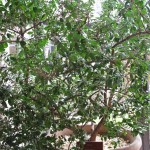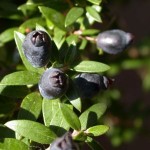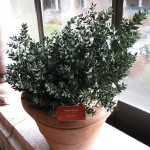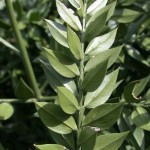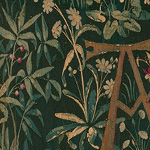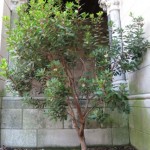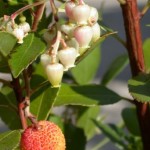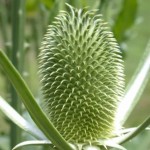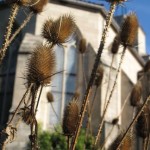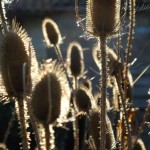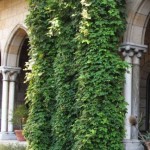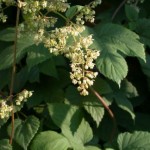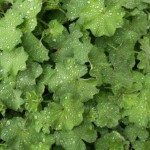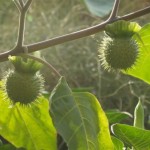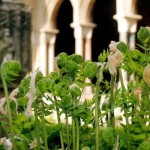Archive for the ‘Gardening at The Cloisters’ Category
Monday, February 1, 2010
Above, from left to right: common myrtle is grown in pots at The Cloisters and brought indoors before frost; detail of the ivory-white blossoms of Myrtus communis; detail of the blue-black fruits of the common myrtle.
In myrtle shades oft sings the happy swain,
In myrtle shades despairing ghost complain.
The myrtle crowns the happy lovers??? heads,
Th??? unhappy lovers’ graves the myrtle spreads.
???Verses Written at The Request of a Gentleman to whom a Lady had Given a Sprig of Myrtle, by Samuel Johnson
This eighteenth-century verse is a deft summation of many centuries of the myrtle???s association with love, lovers, and the goddess of love. Read more »
Tags: Esther, herb, Hippolytus, love, myrtle, myrtus communis, Ovid, Pausanias, perfume, Phaedra, Pliny, Samuel Johnson, unguent
Posted in Food and Beverage Plants, Fragrant Plants, Gardening at The Cloisters | Comments (2)
Friday, January 22, 2010
Above, from left: Butcher???s broom growing in a pot indoors in Cuxa Cloister; detail of the stiff, sharp “leaves,” which are actually modified stems; detail from the tapestry The Hunters Enter the Woods showing Butcher’s broom.
An odd-looking little shrub, Butcher???s broom (Ruscus aculeatus), which reaches a height between one and a half and two feet for us here at The Cloisters, was also known as knee-holly, because of its short stature and prickly nature. (Another old name is “pettygree” or “pettygrew.”) Usually included in the very large lily family, butcher???s broom is a botanical curiosity as well as a household and medicinal plant with a long history of use. Read more »
Tags: asparagus, butcher's_broom, lily, Ruscus_aculeatus
Posted in Gardening at The Cloisters, Medicinal Plants, Useful Plants | Comments (0)
Friday, January 8, 2010
Above, from left to right: Detail from a fifteenth-century panel of The Nativity that shows the Emperor Augustus censing an??apparition of the Virgin and Child; cover of a gilded copper censer in The Cloisters Collection (1979.285); Detail from Panel with Censing Angels, on display in the Treasury at The Cloisters.
The ceremonial use of incense in devotions and rites of purification?? is common to many religious traditions?? and dates back to antiquity. (The incense trade was of great economic importance.)?? While some animal substances such as ambergris and musk are used, most incenses are of botanical origin. Read more »
Tags: bdellium, Commiphora africana, Commiphora myrrha, frankincense, incense, myrrh
Posted in Fragrant Plants, Gardening at The Cloisters | Comments (0)
Wednesday, November 4, 2009
Above, from left: A strawberry tree growing in a sheltered corner in Trie garden; Arbutus unedo in fruit in the woodland of The Unicorn At Bay; the evergreen strawberry tree bears flowers and fruit simultaneously in late October.
A native of the Mediterranean, the strawberry tree (Arbutus unedo) is valued as an ornamental evergreen whose late-blooming flowers and red fruits enliven the garden in late fall and early winter, when few other species are of interest. The common name derives from the description of the tree made by Pliny the Elder, who compares the fruit, with its thin, rough, red rind, to that of the strawberry, Fragaria vesca. Read more »
Tags: Arbutus unedo, strawberry tree
Posted in Food and Beverage Plants, Gardening at The Cloisters, Medicinal Plants, Plants in Medieval Art | Comments (0)
Friday, October 16, 2009
Above, from left to right: The seed head of the cultivated form of teasel (Dipsacus sativus) in a bed devoted to plants used in medieval arts and crafts (2006); detail of the seed head of the teasel growing in the same bed this year; detail of the seed head of common teasel, or fuller???s teasel (D. fullonum),??now in the medicinal bed.
Visitors to Bonnefont Garden are often surprised to find plants that they recognize as common weeds being carefully cultivated in the beds here. One ubiquitous weed found growing in waste places throughout this country is the common or wild teasel, Dipsacus fullonum, a plant which had various medicinal applications in the European Middle Ages. Read more »
Tags: Dipsacus fullonum, Dipsacus sativus, fuller???s teasel
Posted in Gardening at The Cloisters, Medicinal Plants, Useful Plants | Comments (6)
Monday, October 5, 2009
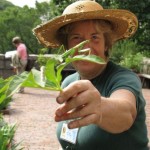
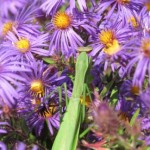
Above, left: Volunteer gardener Nuala Outes befriending a mantis in Bonnefont Garden last summer; right: one of three adult mantises seen recently on the asters now blooming in Cuxa garden.
The European praying mantis is so named because of the manner in which it raises and extends its grasping forelegs before seizing its prey, suggesting an attitude of prayer. This omnivorous species was not among the beneficial insects released in the gardens this summer as part of our biological pest control program, although several mantises already inhabited Trie and Bonnefont gardens. However, the mantis population does seem to be on the rise, and no less than three of the insect predators were recently spied in Cuxa garden on a windy day, clinging to a single planting of ‘Hella Lacy,’ a cultivated form of the native New York aster now blooming along the roadsides.
The sexual cannibalism for which the mantis is notorious seems to be more common in captivity; it is less frequently and readily observed by entomologists in the field and is the subject of scholarly debate. Autumn is the mating season for praying mantises in our climate, although we haven???t observed any unions. The compound eyes and binocular vision over a wide field—characteristic of mantises—make them at least as aware of us as we are of them, and they clearly register their consciousness of our presence when we encounter them in the gardens.
—Deirdre Larkin
Tags: aster, cannibalism, hella_lacy, insect, mantis_religiosa, omnivore, praying_mantis, predator
Posted in Gardening at The Cloisters | Comments (5)
Thursday, October 1, 2009
Above, from left to right: Hop bines grown in Bonnefont Cloister garden send out new shoots in March, reaching the roofline by the end of May and dying back to the ground in late autumn; a hop bine bearing female flowers, called cones, adorns the abacus of a column from Saint-Guilhem Cloister; detail of a bine bearing a male flower.
Hop (Humulus lupulus) has been used as a vegetable (according to the Roman natural historian Pliny, the young shoots of the plant were eaten), as both fodder and bedding for cattle, as a dye, and, like its close relative hemp (Cannabis sativa), as a fiber plant. It also appears as a medicament in medieval and Renaissance herbals. The fifteenth-century Herbarius Latinus recommends hops for purifying the blood, opening obstructions of the spleen, easing fever, and curing both headache and jaundice. However, the most important economic use of hops in the Middle Ages and at the present writing is in brewing beer. Read more »
Tags: beer, bine, brew, cannabis sativa, dioecious, hemp, hop, humulus lupulus
Posted in Food and Beverage Plants, Gardening at The Cloisters, Medicinal Plants, Useful Plants | Comments (0)
Wednesday, September 16, 2009
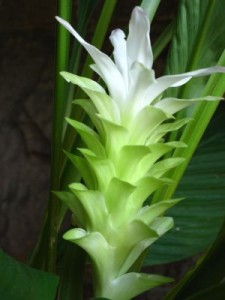
Turmeric (Curcuma longa), a native of India, flowering in the arcade of Bonnefont Cloister. Turmeric and other tender exotics in the collection are grown in pots.
The plant collection at The Cloisters includes a number of exotic species that would not have been??grown in medieval European gardens, but whose dried roots, seeds, bark, or other parts were imported for use in food and medicine. Read more »
Tags: Curcuma longa, turmeric, Zingiberaceae
Posted in Food and Beverage Plants, Gardening at The Cloisters, Medicinal Plants | Comments (0)
Thursday, June 11, 2009
Above, from left to right: lady’s mantle (Alchemilla mollis) in Cuxa Cloister; downy thornapple (Datura metel) in Bonnefont Garden; fiddleheads of the royal fern (Osmunda regalis) in Trie Cloister. All photographs by the author, Barbara Bell.
There is a garden tool that may not be in your shed, but it’s one that I use frequently: a camera. It’s handy to take photos of plant labels when I visit botanical gardens, and it helps me keep a visual record of the plants and planting combinations that pique my interest. Read more »
Tags: Alchemilla mollis, Datura, fiddleheads, photography
Posted in Gardening at The Cloisters | Comments (8)
Friday, May 15, 2009
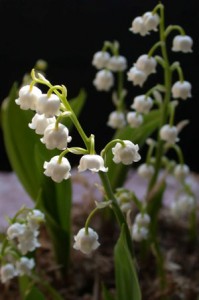
Above: Lily of the valley (Convallaria majalis)
White coral bells upon a slender stalk
Lilies-of-the-valley deck my garden walk. . . .
???Traditional English Round
In spite of its medieval association with the exotic Queen of Sheba (see last week’s post), this modest, northern European woodland flower is actually as easy to grow as it is familiar. Read more »
Tags: Convallaria majalis, lily of the valley
Posted in Botany for Gardeners, Fragrant Plants, Gardening at The Cloisters, Medicinal Plants, Plants in Medieval Art | Comments (7)
